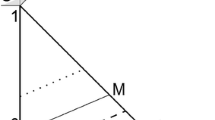Abstract
A thermodynamical model for martensitic phase transitions in shape memory alloys is formulated in this paper in the framework of the Ginzburg-Landau approach to phase transitions. A single order parameter is chosen to represent the austenite parent phase and two mirror related martensite variants. A free energy previously proposed in the literature (Levitas et al. in Phys. Rev. B 66:134206, 2002; Phys. Rev. B 66:134207, 2002; Phys. Rev. B 68:134201, 2003) is employed, in its simplest form, as the main constitutive content of the model. In this paper we treat time-dependent Ginzburg-Landau equation as a balance law on the structure order and we couple it to a energy balance equation, thus allowing to account of heat transfer processes. We obtain a coupled thermo-mechanical problem whose consistency with the Second Law is verified.
Finally, a suggestion to expand the proposed model to a full three-dimensional description which accounts for the formation of different martensite variants is proposed.
Similar content being viewed by others
References
Otsuka K, Wayman CM (1999) Shape memory materials. Cambridge University Press, Cambridge
Ölander A (1932) An electrochemical investigation of solid cadmium-gold alloys. J Am Chem Soc 54:3819–3833
Chang LC (1951) Atomic displacements and crystallographic mechanism in diffusionless transformation of gold-cadmium single crystals containing 47.5 atomic percent cadmium. Acta Crystallogr 4:320–324
Buehler WJ, Gilfrich JV, Wiley RC (1963) Effect of low-temperature phase changes on the mechanical properties of alloys near composition TiNi. J Appl Phys 345:1475–1477
Goo RC, Lexcellent C (1997) Micromechanics-based modeling of two way memory effect of a single crystalline shape memory alloy. Acta Mater 45:727–737
Brocca M, Brinson LC, Bazant ZP (2002) Three-dimensional constitutive shape memory alloys based on microplane model. J Mech Phys Solids 50:1051–1077
Bhattacharya K (2003) Microstructure of martensite. Oxford University Press, Oxford
Tanaka K (1986) A thermomechanical sketch of shape memory effect: one dimensional tensile behavior. Res Mech 18:251–263
Liang C, Rogers CA (1990) One-dimensional thermomechanical constitutive relations for shape memory materials. J Intell Mater Syst Struct 1(2):207–234
Brinson LC (1993) One-dimensional constitutive behavior of shape memory alloys: thermomechanical derivation with non-constant material functions and redefined martensite internal variable. J Intell Mater Syst Struct 4:229–242
Patoor E, Lagoudas DC, Entchev PB, Brinson LC, Gao X (2006) Shape memory alloys, Part I: General properties and modeling of single crystals. Mech Mater 38:391–429
Lagoudas DC, Entchev PB, Popov P, Patoor E, Brinson LC, Gao X (2006) Shape memory alloys, Part II: Modeling of polycrystals. Mech Mater 38:430–462
Falk F (1983) One-dimensional model o shape memory alloys. Arch Mech 35:63–84
Levitas VI, Preston PD, Lee DW (2002) Three-dimensional Landau theory for multivariant stress-induced martensitic phase transformations. I. Austenite↔martensite. Phys Rev B 66:134206
Levitas VI, Preston PD, Lee DW (2002) Three-dimensional Landau theory for multivariant stress-induced martensitic phase transformations. II. Multivariant phase transformations and stress space analysis. Phys Rev B 66:134207
Levitas VI, Preston PD, Lee DW (2003) Three-dimensional Landau theory for multivariant stress-induced martensitic phase transformations. III. Alternative potentials, critical nuclei, kink solutions, and dislocation theory. Phys Rev B 68:134201
Mahapatra DR, Melnik RVN (2006) Finite element analysis of phase transformation dynamics in shape memory alloys with a consistent Landau-Ginzburg free energy model. Mech Adv Mater Struct 13:443–455
Fabrizio M (2006) Ginzburg-Landau equations and first and second order phase transitions. Int J Eng Sci 44:529–539
Fabrizio M, Giorgi C, Morro A (2006) A thermodynamic approach to non-isothermal phase-field evolution in continuum physics. Physica D 214:144–156
Fabrizio M, Morro A (1992) Mathematical problems in linear viscoelasticity. SIAM Stud Appl Math, vol 12. SIAM, Philadelphia
Fried F, Gurtin ME (1993) Continuum theory of thermally induced phase transitions based on an order parameter. Physica D 68:326–343
Fremond M (2002) Non-smooth thermomechanics. Springer, Berlin
Levitas VI, Lee D-W, Preston DL (2006) Phase field theory of surface- and size-induced microstructures. Europhys Lett 76:81–87
Idesman AV, Cho J-Y, Levitas VI (2008) Finite element modelling of dynamics of martensitic phase transitions. Appl Phys Lett 93:043102
Idesman AV, Levitas VI, Preston DL, Cho J-Y (2005) Finite element simulations of martensitic phase transitions and microstructures based on a strain softening model. J Mech Phys Solids 53:495–523
Author information
Authors and Affiliations
Corresponding author
Rights and permissions
About this article
Cite this article
Daghia, F., Fabrizio, M. & Grandi, D. A non isothermal Ginzburg-Landau model for phase transitions in shape memory alloys. Meccanica 45, 797–807 (2010). https://doi.org/10.1007/s11012-010-9286-z
Received:
Accepted:
Published:
Issue Date:
DOI: https://doi.org/10.1007/s11012-010-9286-z




